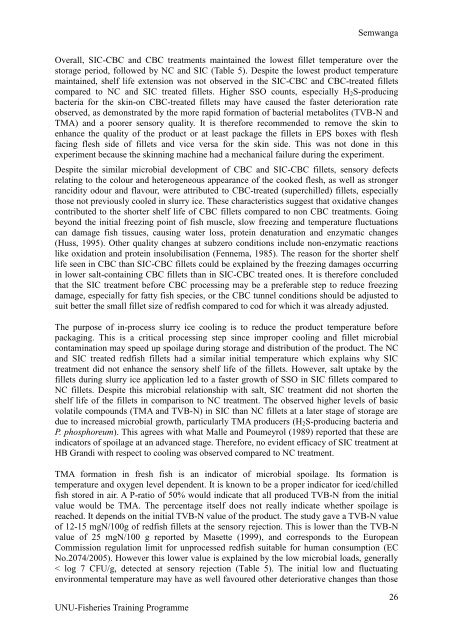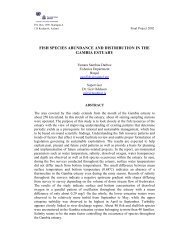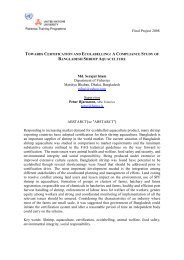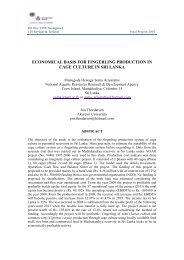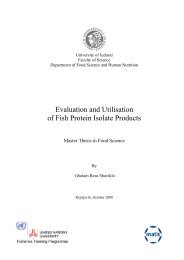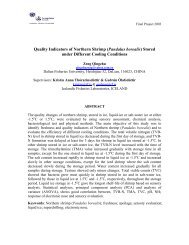THE EFFECT OF DIFFERENT COOLING TECHNIQUES ON THE ...
THE EFFECT OF DIFFERENT COOLING TECHNIQUES ON THE ...
THE EFFECT OF DIFFERENT COOLING TECHNIQUES ON THE ...
Create successful ePaper yourself
Turn your PDF publications into a flip-book with our unique Google optimized e-Paper software.
SemwangaOverall, SIC-CBC and CBC treatments maintained the lowest fillet temperature over thestorage period, followed by NC and SIC (Table 5). Despite the lowest product temperaturemaintained, shelf life extension was not observed in the SIC-CBC and CBC-treated filletscompared to NC and SIC treated fillets. Higher SSO counts, especially H 2 S-producingbacteria for the skin-on CBC-treated fillets may have caused the faster deterioration rateobserved, as demonstrated by the more rapid formation of bacterial metabolites (TVB-N andTMA) and a poorer sensory quality. It is therefore recommended to remove the skin toenhance the quality of the product or at least package the fillets in EPS boxes with fleshfacing flesh side of fillets and vice versa for the skin side. This was not done in thisexperiment because the skinning machine had a mechanical failure during the experiment.Despite the similar microbial development of CBC and SIC-CBC fillets, sensory defectsrelating to the colour and heterogeneous appearance of the cooked flesh, as well as strongerrancidity odour and flavour, were attributed to CBC-treated (superchilled) fillets, especiallythose not previously cooled in slurry ice. These characteristics suggest that oxidative changescontributed to the shorter shelf life of CBC fillets compared to non CBC treatments. Goingbeyond the initial freezing point of fish muscle, slow freezing and temperature fluctuationscan damage fish tissues, causing water loss, protein denaturation and enzymatic changes(Huss, 1995). Other quality changes at subzero conditions include non-enzymatic reactionslike oxidation and protein insolubilisation (Fennema, 1985). The reason for the shorter shelflife seen in CBC than SIC-CBC fillets could be explained by the freezing damages occurringin lower salt-containing CBC fillets than in SIC-CBC treated ones. It is therefore concludedthat the SIC treatment before CBC processing may be a preferable step to reduce freezingdamage, especially for fatty fish species, or the CBC tunnel conditions should be adjusted tosuit better the small fillet size of redfish compared to cod for which it was already adjusted.The purpose of in-process slurry ice cooling is to reduce the product temperature beforepackaging. This is a critical processing step since improper cooling and fillet microbialcontamination may speed up spoilage during storage and distribution of the product. The NCand SIC treated redfish fillets had a similar initial temperature which explains why SICtreatment did not enhance the sensory shelf life of the fillets. However, salt uptake by thefillets during slurry ice application led to a faster growth of SSO in SIC fillets compared toNC fillets. Despite this microbial relationship with salt, SIC treatment did not shorten theshelf life of the fillets in comparison to NC treatment. The observed higher levels of basicvolatile compounds (TMA and TVB-N) in SIC than NC fillets at a later stage of storage aredue to increased microbial growth, particularly TMA producers (H 2 S-producing bacteria andP. phosphoreum). This agrees with what Malle and Poumeyrol (1989) reported that these areindicators of spoilage at an advanced stage. Therefore, no evident efficacy of SIC treatment atHB Grandi with respect to cooling was observed compared to NC treatment.TMA formation in fresh fish is an indicator of microbial spoilage. Its formation istemperature and oxygen level dependent. It is known to be a proper indicator for iced/chilledfish stored in air. A P-ratio of 50% would indicate that all produced TVB-N from the initialvalue would be TMA. The percentage itself does not really indicate whether spoilage isreached. It depends on the initial TVB-N value of the product. The study gave a TVB-N valueof 12-15 mgN/100g of redfish fillets at the sensory rejection. This is lower than the TVB-Nvalue of 25 mgN/100 g reported by Masette (1999), and corresponds to the EuropeanCommission regulation limit for unprocessed redfish suitable for human consumption (ECNo.2074/2005). However this lower value is explained by the low microbial loads, generally< log 7 CFU/g, detected at sensory rejection (Table 5). The initial low and fluctuatingenvironmental temperature may have as well favoured other deteriorative changes than thoseUNU-Fisheries Training Programme26


